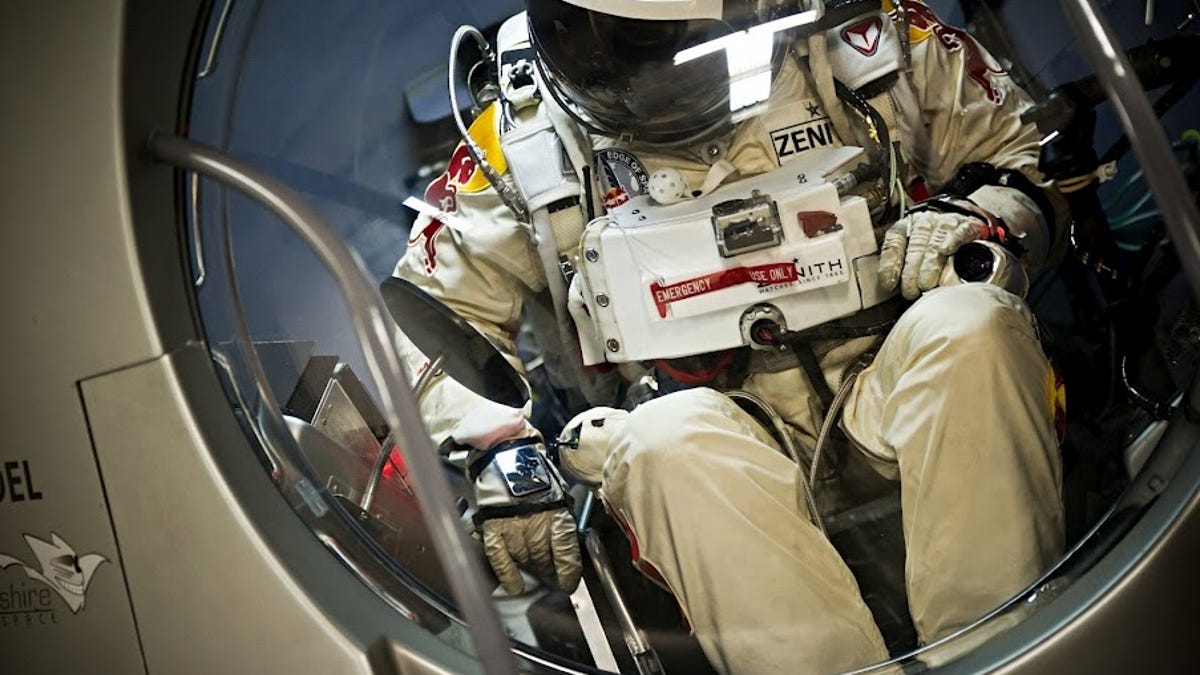Skydiver aims to go supersonic October 8, finally
Felix Baumgartner isn't your garden-variety parachutist. And now he's got the nearly final green light to go for the breathtaking, record-setting gusto.

If you're going to try to zip through the air faster than the speed of sound -- without an airplane, and straight down to boot -- well, that's not something you rush into.
And it's been a long haul indeed for Austrian daredevil Felix Baumgartner, who for years now has been planning to make a historic skydive from higher than anyone's ever jumped, and faster too. As in supersonic fast.
Today, the team behind Baumgartner finally put a long-delayed date to the skydive: October 8. OK, actually, that's a tentative date, since the final green light for the jump will depend upon the weather that day. But that's more specific than the Red Bull Stratos team has ever been to this point; the most they've committed to in the past was along the lines of "later this year."
The place will be Roswell, N.M., or perhaps better said, the skies over Roswell.
If all goes according to plan, Baumgartner would be the first person ever to go supersonic in freefall. He would also set a record for the highest altitude at which a skydive has begun -- 120,000 feet (23 miles), or as Red Bull Stratos also puts it, with no hyperbole, "from the edge of space."
That would eclipse the mark set by Joe Kittinger, an Air Force officer who in August 1960 departed the relative safety of a balloon gondola at 102,800 feet (19.5 miles), sailing back to Earth at a top speed of about 614 miles per hour. Baumgartner is aiming to zoom along at 690 mph or so. In both cases, the superfast speed comes before the parachute is deployed.
Kittinger's effort came in the early days of the U.S. space program, and when supersonic aircraft were still relatively novel, when researchers wanted to learn whether it was possible for a pilot, or an astronaut, to safely eject from such rarefied heights. At those altitudes, even in an aircraft, a pressurized suit is a necessity -- without one, a person's blood could, in effect, boil.
While the 43-year-old Baumgartner, a native of Austria, is known for his extreme sports approach to skydiving, the Red Bull Stratos project is also a full-on scientific and medical research effort.
Baumgartner will make his 2.5-hour ascent in a gondola under an 850,000-cubic-meter helium balloon, though his will be pressurized, unlike Kittinger's. Consider it a space capsule, really, one about the size and weight of a VW Beetle. Kittinger, by the way, is one of his advisers.
In an interview with NPR in May, Baumgartner described the feeling of skydiving from an outrageous altitude, referring in this case to a jump from 72,000 feet earlier in the year:
You know, the sky is totally black. And in freefall, you don't really realize how fast you are. I was flying at 380 miles an hour, but you don't have any sensational speed at all because you don't have reference points. Nothing is passing by. You don't have noise at that altitude. So it pretty much feels like a normal skydive, which is the sad part of it.
Normal, that is, unless you go out of control in a fatal flat spin.
The most recent setback for the project was damage sustained by the capsule during the final practice jump in July. For that jump, Baumgartner ascended to about 97,000 feet, or about a mile below Kittinger's mark, and in his freefall reached a speed of about 537 mph.
Baumgartner had planned to make the jump in 2010, but at that time was derailed by a lawsuit over the rights to the project.
The team is, as they say, cautiously optimistic about the October 8 date. "Early fall in New Mexico is one of the best times of the year to launch stratospheric balloons," said mission meteorologist Don Day in a statement.

